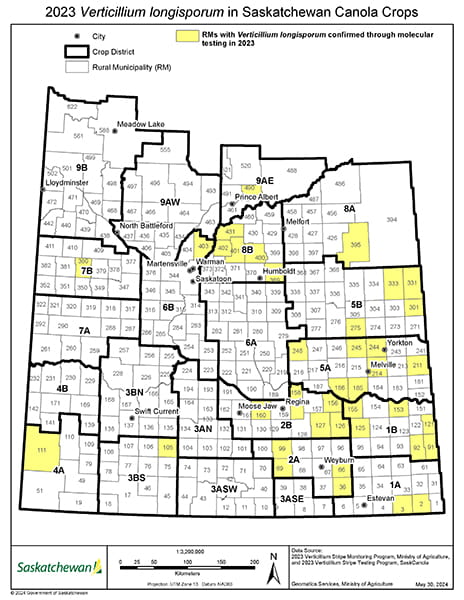Aug 2, 2024 – Researchers detected verticillium stripe, caused by the pathogen Verticillium longisporum, in canola in Manitoba in 2014. Since then, the disease has been found across the Prairies, causing yield loss and lodging in some fields.
Disease surveys from the three Prairie provinces indicate how widespread the disease is and its severity.
Manitoba 2023
Surveyors participating in the Manitoba Agriculture and Agriculture and Agri-Food Canada survey assessed 129 canola crops between August 2-30, 2023, in the major canola production regions of Manitoba. Most of the fields were ripening, not yet swathed or combined, when surveyed.
Disease prevalence is the percentage of fields surveyed that have infection in them. The average prevalence was 29 per cent for verticillium stripe. Incidence is the percentage of plants surveyed within a field that have disease symptoms. Average incidence in infected crops was 11 per cent. Learn more, including detailed results from the last five years, in the Manitoba Canola Disease Survey for 2023 report.
Saskatchewan 2023
In 2023, the Saskatchewan Ministry of Agriculture surveyed 218 fields through the general canola disease survey and an additional 103 fields after harvest. Results confirmed verticillium stripe in 25 fields in 23 rural municipalities (RMs). SaskCanola also expanded its disease testing program last year to include verticillium stripe, which found the disease in an additional 16 RMs, bringing the total to 39. (See the map for RMs with known verticillium stripe.) Find more details in the Sask Ag article Verticillium longisporum in Saskatchewan Canola.
Alberta 2023
In Alberta, 356 fields were included in the 2023 disease survey, resulting in verticillium stripe prevalence at 18.2 per cent and incidence at 0.9 per cent. The complete plant disease situation from 2023 will be posted in the Canadian Plant Disease Survey once finalized.
What can growers and agronomists do?
- Verticillium microsclerotia are soil-borne. Steps to keep soil in place could provide some reduction in spread.
- Two- or three-year breaks between canola crops is a disease management best practice. This should help reduce verticillium severity, although verticillium microsclerotia can remain viable for many years.
- Scout effectively. If you suspect disease, submit samples for testing.
- Use this guide when scouting to differentiate between verticillium stripe or blackleg.
- PSI lab in Manitoba, 20/20 Seed Labs in Alberta and Discovery Seed Labs in Saskatchewan test canola for verticillium stripe.
- Members of the Manitoba Canola Growers quality for free testing through PSI with their #GetTested program. For non-members, the cost is $200.
- Participate in SaskCanola’s disease monitoring program in partnership with the Saskatchewan Ministry of Agriculture. The first 200 registered canola growers who participate are eligible for a free blackleg and verticillium stripe test. Email blacklegtesting@saskcanola.com to participate.
- Watch the video “How to collect canola samples for verticillium stripe testing” at youtube.com/canolacouncil.
- Get involved.
- In Manitoba, contact David Kaminski, field crop pathologist with Manitoba Agriculture, at David.Kaminski@gov.mb.ca to participate in the 2024 survey and ask questions about the disease survey process or results.
- To support the crop disease surveying efforts in Saskatchewan, fill out the Pest Monitoring Sign-up Form and/or become a Volunteer Crop Reporter for the coming growing season.
What’s next?
In the long term, we are hopeful that genetic resistance or tolerance will provide the best solution for control. Currently canola breeders are actively working to develop this trait.
Research is also underway to help quantify yield loss from verticillium stripe across the Prairies. Four Canola Research Agronomic Program (CARP) projects are investigating the disease. Learn more about them in this Canola Research Hub blog.
To learn more about verticillium stripe, check out the Canola Encyclopedia, or this Canola Watch fundamentals article: How to identify verticillium stripe. While there, please sign up to receive the weekly Canola Watch e-newsletter, answering the top canola agronomy questions from across the Prairies.
